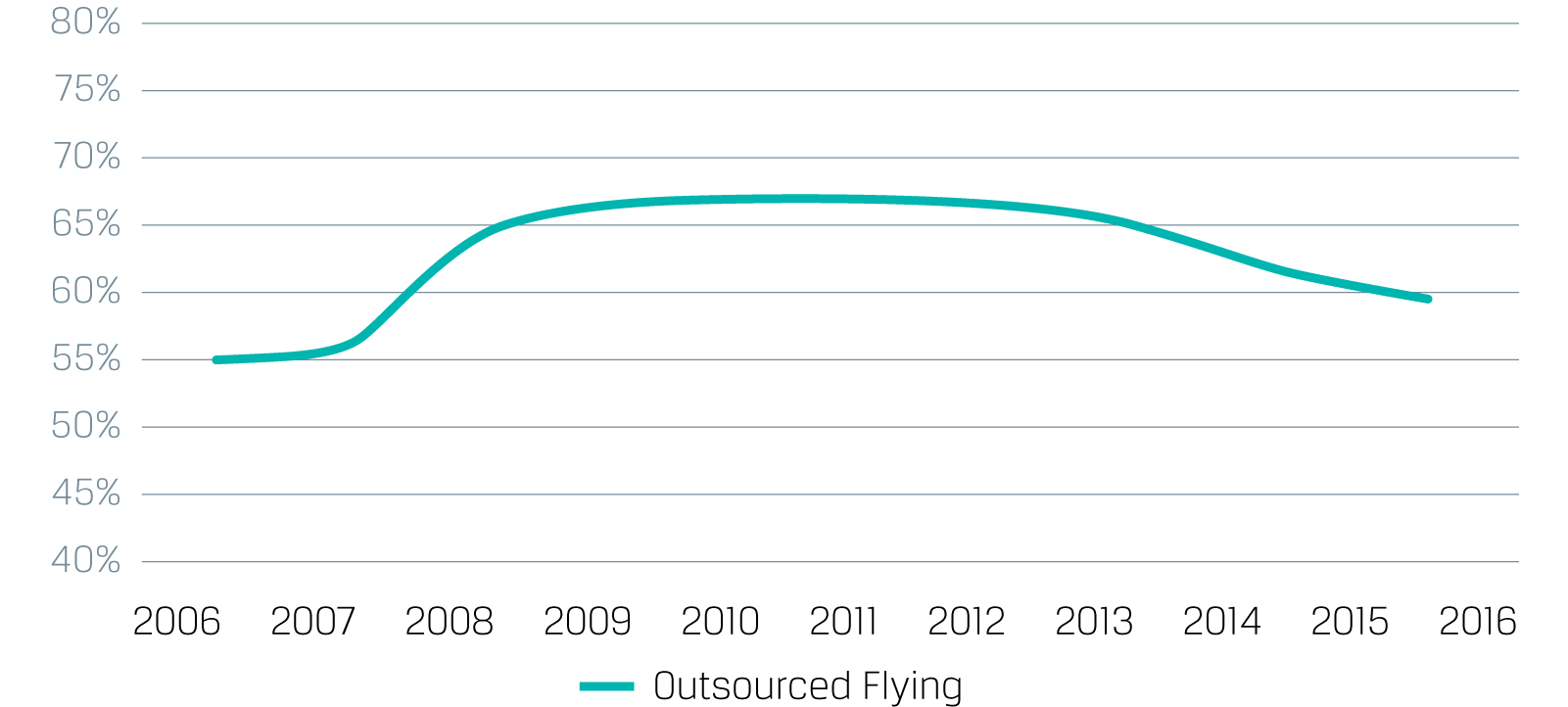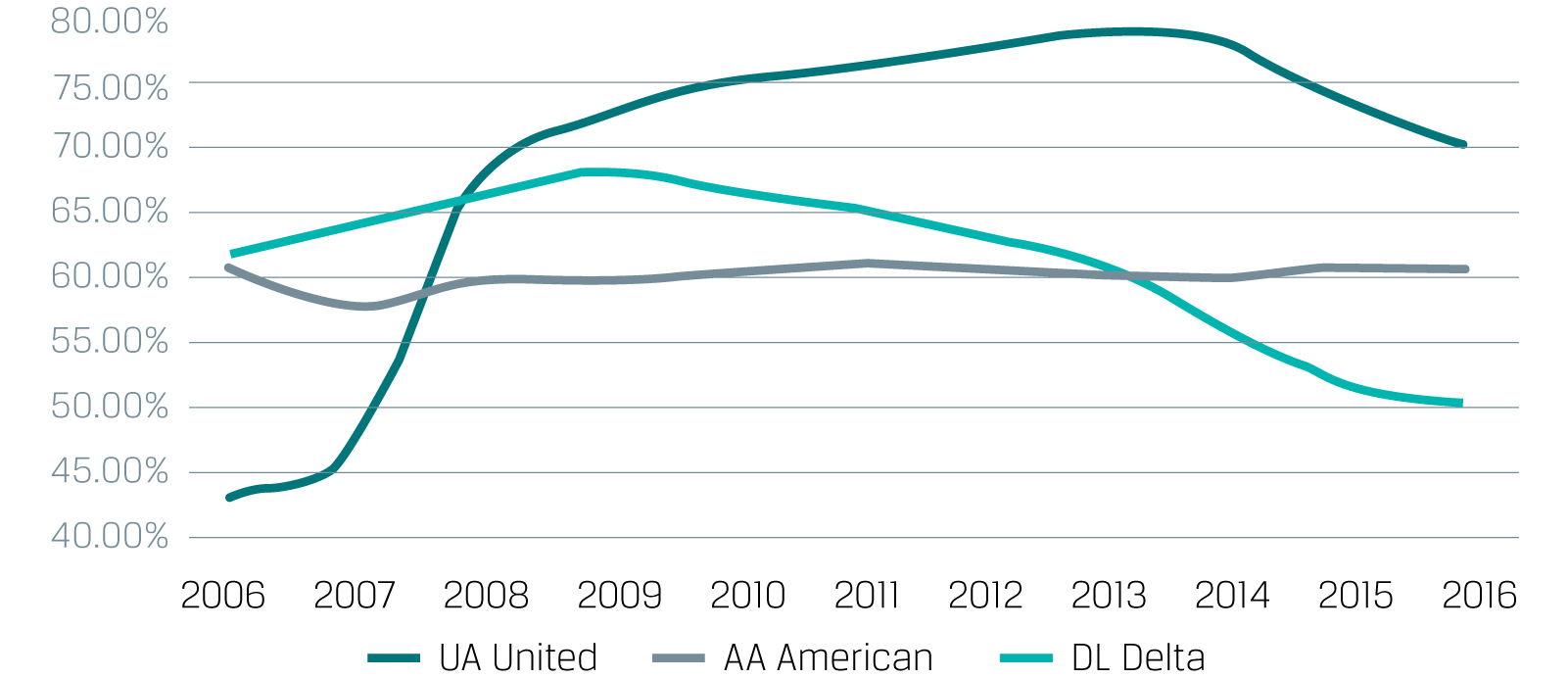Yes, air travel is worse for passengers than it used to be (but it's getting better)
Airlines are outsourcing fewer flights these days — and that could be a good thing for unhappy passengers.
The “friendly skies” haven’t seemed so amicable these days. A recent spate of PR disasters has reignited passenger concerns about the comfort and safety of air travel, but a new trend among major U.S. carriers could help change that.
Airline Outsourcing: When Delta isn’t Exactly… Delta
If you bought a Delta ticket for a flight from Washington, D.C. to New York in 2010, chances are you traveled on a flight that wasn’t actually operated by Delta. In 2010, the three major U.S. carriers — Delta, American, and United — adopted a practice known as airline outsourcing. This resulted in nearly 70 percent of all domestic short-haul flights (those traveling fewer than 1000 miles) being managed and flown by another carrier.
U.S. Domestic Short-haul Outsourced Flying by U.S. Legacy Airlines

Short-haul flying is defined as less than 1,500 miles Source: PaxIS SRS Schedule Analyzer, December 2016; excludes point-to-point flying
New numbers, however, show that major carriers are starting to buck the trend. By 2016, major carriers outsourced closer to 60 percent of domestic flights1 — and the percentage is still declining. Here’s why:
-
Fewer Regional Pilots:
After years of low wages, slow career advancement, and a rising cost of flight training, many aspiring professional pilots were dissuaded from pursuing careers at regional airlines. New federal regulations increased the minimum flying time for Airline Transport Pilot certification from 250 to 1,500 hours.2 As labor supply declined — and demand remained steady — big airlines struggled to find reliable regional partners. The solution? Move more of these operations in house. -
Low Fuel Prices and Explosion of Ultra Low Cost Carriers (ULCCs) Force Lower Fares:
Low fuel prices make it more economically feasible for airlines to carry a larger number of lower-yielding passengers, or those who travel for leisure rather than, say, business (the former has more flexibility to shop for better fares). Furthermore, the past six years have seen the explosion of ULCCs such as Spirit and Frontier, which have put pressure on legacy carriers to offer lower fares. These fares are even less economical with high cost per available seat mile (CASM) on regional jets. -
Focus on Better Customer Experience:
After resurging from 9/11 demand shocks and a string of airline bankruptcies, the post-consolidation legacy carriers have emerged stronger than ever. Lower fuel prices have enabled major carriers to spend more on customer amenities, like Wi-Fi, increased legroom in the economy section, enhanced in-flight entertainment, and overall improved premium cabin experience. These features are more difficult or impossible to replicate in smaller regional jets that are operated by outsourced labor.
Major Airlines Are Handling Outsourcing in Different Ways
United, for instance, currently outsources the most regional flights, while Delta outsources the fewest. American Airlines has remained fairly stable over time. The striking trend can be seen in the great increase in percent of outsourced flights at United between 2007 and 2008 (Exhibit 2). In United’s case, the relatively high number of outsourced flights stems from an equipment-related issue. In 2008, the carrier retired its fleet of almost 100 classic 737s and used regional carriers to backfill the demand. American, alternately, has just undergone the most recent merger, may need more time to fine tune capacity and integrate its regional network.
U.S. Domestic Short-haul Outsourced Flying by U.S. Legacy Airlines

Source: PaxIS SRS Schedule Analyzer; 2006-2016
Beyond the strategic commitment that Delta has made to provide more of its passengers with a superior airline experience, much of its more robust presence in short-haul markets can likely be attributed to the relative size of its major hubs, or airports where the majority of an airline’s flights are concentrated.
Looking at Delta’s entire route network, data shows that approximately 40 percent of hub seats are allocated to its fortress hub — an airport where a single carrier controls most of the market — in Atlanta (ATL). This allows Delta to achieve tremendous scale, meaning that it can funnel larger mainline aircraft into ATL. That airport then has a greater number of connecting opportunities for these passengers. In contrast, American and United have less concentrated hubs: only about 24 percent and 20 percent of seats are allocated to their largest respective hubs in Detroit (DFW) and Chicago (ORD). Less concentrated hubs that are more even in size means less feed through these hubs. It also necessitates more outsourced regional flying in many markets.
Allocation of System Seats at Top 4 Hubs of U.S. Legacy Carriers
| Delta | American | United | ||||||
|---|---|---|---|---|---|---|---|---|
| Hub | % Seats |
| Hub | % Seats |
| Hub | % Seats |
|
| ATL | 40% |
| DFW | 24% |
| ORD | 20% |
|
| DTW | 13% |
| CLT | 19% |
| IAH | 20% |
|
| MSP | 13% |
| MIA | 13% |
| EWR | 17% |
|
| SLC | 8% |
| ORD | 12% |
| DEN | 14% |
|
What the Trend Means for Passengers and Airlines…
Airline managers must deal with an increase in labor cost, since more short-haul flying is being performed by more expensive mainline crews. This is partially offset by the increase in seats, spreading fixed costs between more passengers and reducing CASM. Since this trend may result in mainline jets flying into smaller markets, it will put pressure on load factors as airlines struggle to fill larger aircraft.
Carrier employees will benefit from higher paying mainline jobs for pilots and flight attendants. While a reduction in U.S. legacy carrier outsourcing is at the expense of regional airlines, for reasons described earlier, regional labor demand currently exceeds labor supply at the moment.
Customers may have a better inflight experience. Mainline jets often provide a more spacious cabin, inflight entertainment, increased legroom seating, and a premium cabin experience. The downside? More flights operated by mainline carriers may mean fewer total flight options.
Despite the benefits that come with less outsourcing, major airlines might struggle to keep in-house costs under control, fill planes, and provide enough flights on important business routes. All that said, we should expect the trend to continue — albeit at a gradual pace — since many of the drivers described above aren’t going away anytime soon.
Have you had a subpar experience with an outsourced flight? Tell us what you think on Facebook, Twitter, and LinkedIn.
- 1PaxIS SRS Schedule Analyzer, December 2016; excludes point-to-point flying
- 2https://www.faa.gov/news/press_releases/news_story.cfm?newsId=14838